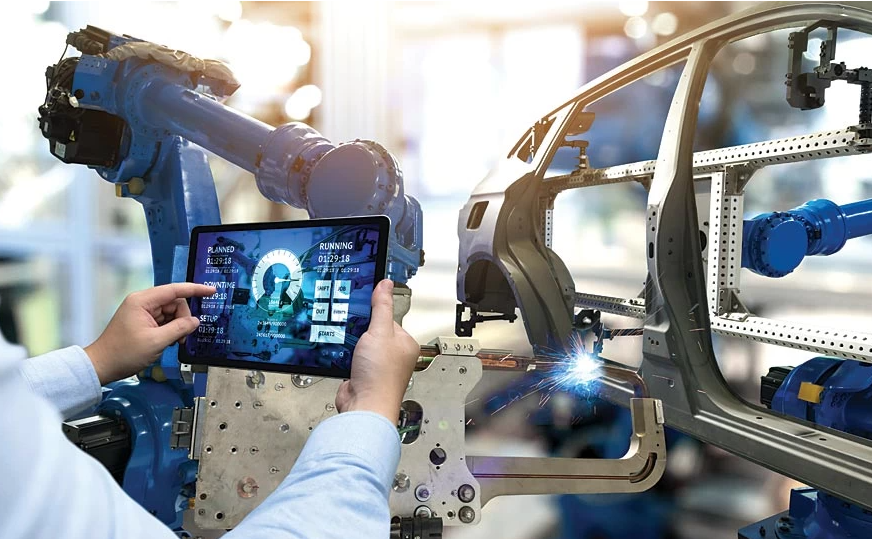Introduction
Automation in manufacturing refers to the use of technology to perform tasks that would otherwise require human labor. The introduction of automation has revolutionized various industries, especially manufacturing, enabling businesses to produce goods at a higher rate, with better precision and lower costs. As new technologies continue to emerge, automation’s role in reshaping the manufacturing landscape is becoming increasingly evident. In this article, we’ll explore how automation is transforming manufacturing and what this means for the future.
The Evolution of Manufacturing Automation
1.1 Historical Context: From Manual Labor to Robotics
Manufacturing has always relied on human labor to assemble products, but over the decades, the industrial revolution paved the way for mechanized processes. The introduction of machines like the steam engine and the conveyor belt marked the early steps toward automation. In the late 20th century, the advent of robotics in manufacturing took the industry to new heights, reducing the need for manual work and boosting production capabilities.
See also: Exploring the Role of Big Data in Business Decision-Making
1.2 Key Drivers of Automation in the Manufacturing Sector
The drive for automation in manufacturing is largely driven by the need for efficiency, cost savings, and improved quality control. Factors such as the global demand for faster production cycles, labor shortages, and the rise of digital technologies have accelerated the adoption of automation in the industry.
Technological Advancements Fueling Automation
2.1 Robotics and AI Integration
Robotic systems equipped with artificial intelligence (AI) are revolutionizing manufacturing processes. Robots can perform repetitive tasks such as assembling, packaging, and welding with incredible precision and speed. AI enables these robots to adapt and learn from their environment, optimizing their performance over time and handling complex tasks that were once thought to be impossible for machines.
2.2 Internet of Things (IoT) in Manufacturing
The IoT connects machines, sensors, and systems within a factory, allowing them to communicate in real time. This connection helps manufacturers monitor performance, track resources, and identify issues before they become critical. By integrating IoT with automation, factories can run more efficiently and with fewer interruptions, making predictive maintenance a reality.
2.3 3D Printing and Additive Manufacturing
3D printing, or additive manufacturing, is another critical advancement in automation. This technology allows manufacturers to create prototypes and final products directly from digital files, reducing material waste and production costs. As 3D printing technology continues to advance, it’s expected to play a larger role in customized and on-demand production.
Increased Efficiency and Productivity
3.1 Speed and Precision Improvements
One of the biggest benefits of automation in manufacturing is the speed at which production can occur. Robots and automated machines can work 24/7 without the need for breaks or sleep. Additionally, their precision ensures that products are consistently produced with minimal defects, reducing waste and increasing the overall quality of the output.
3.2 Reducing Human Error and Downtime
Human error is one of the leading causes of defects and production delays in manufacturing. Automation reduces this risk by allowing machines to perform tasks with a level of accuracy that humans cannot achieve. Furthermore, automated systems can monitor themselves for malfunctions, significantly reducing downtime and maintenance costs.
Improved Quality Control
4.1 Automated Inspection Systems
Quality control is a critical aspect of manufacturing, and automation has significantly improved it. Automated inspection systems, using cameras and sensors, can detect flaws that may be invisible to the human eye. These systems can scan thousands of products per minute, ensuring that only the highest quality goods are shipped to customers.
4.2 Real-Time Monitoring for Consistent Quality
With automation, manufacturers can implement real-time quality control processes. By continuously monitoring product output, manufacturers can catch any deviations from quality standards early in the production process, allowing for quicker adjustments and preventing defective products from reaching the consumer.
Cost Reduction and Profit Maximization
5.1 Lower Operational Costs
By automating repetitive and time-consuming tasks, manufacturers can reduce labor costs significantly. Robots can work without the need for benefits, healthcare, and other human-related expenses. Additionally, automated systems can improve energy efficiency, further cutting down on operational costs.
5.2 Optimizing Resource Allocation
Automation allows for better utilization of resources, from raw materials to human labor. Automated systems can predict the exact amount of material needed for production, reducing waste and ensuring that production processes are as lean as possible. This level of efficiency allows manufacturers to allocate resources to areas that will provide the highest return on investment.
Human Workforce Evolution
6.1 New Job Opportunities in Automation
While automation may replace some jobs, it also creates new ones. As companies implement more automated systems, the demand for workers to manage, repair, and optimize these systems grows. Positions in fields like robotics, AI programming, and data analysis are on the rise as automation takes hold in the manufacturing sector.
6.2 Reskilling and Upskilling of Workers
To keep up with automation trends, workers are required to acquire new skills. Many manufacturing employees are undergoing reskilling programs to adapt to the new technological landscape. Companies and educational institutions are working together to ensure that workers can transition into new roles that leverage automation and technology.
Challenges and Concerns in Automated Manufacturing
7.1 Cybersecurity and Data Privacy
As manufacturing systems become more interconnected through IoT and AI, cybersecurity becomes a critical concern. Protecting sensitive production data and safeguarding against cyber-attacks is an ongoing challenge. Manufacturers must invest in robust cybersecurity measures to protect their systems and data from potential threats.
7.2 The Initial Investment Cost for Automation
One of the biggest challenges for manufacturers is the high upfront cost associated with implementing automation. Although automation offers long-term savings, the initial investment in robotics, AI systems, and training can be prohibitive for small and medium-sized enterprises. However, as technology becomes more accessible and affordable, this barrier is slowly being reduced.
The Future of Manufacturing Automation
8.1 Predicting the Next Frontier in Manufacturing
The future of manufacturing automation holds exciting possibilities. Technologies such as collaborative robots (cobots), machine learning, and augmented reality (AR) are poised to further transform the industry. These advancements will enable more flexible production processes, real-time customization, and smarter supply chains.
8.2 Impact on Global Manufacturing Supply Chains
Global supply chains will also see significant changes due to automation. With the ability to produce goods more efficiently and on-demand, manufacturers will be able to streamline their supply chains, reducing lead times and enhancing responsiveness to market demands. Automation will facilitate localized production, reducing the reliance on distant, often fragile, supply chains.
FAQs
Q1: How does automation improve manufacturing efficiency?
Automation improves efficiency by speeding up production, reducing human error, and optimizing resource allocation, allowing manufacturers to produce more at a lower cost.
Q2: Will automation lead to job losses in manufacturing?
While some jobs may be replaced by automation, new roles in robotics maintenance, programming, and system management are being created, requiring workers to adapt and reskill.
Q3: How does automation impact product quality?
Automation ensures consistent quality by using precise, real-time monitoring and automated inspection systems, minimizing human errors and defects.
Q4: What are the main challenges associated with implementing automation in manufacturing?
Challenges include high initial investment costs, cybersecurity concerns, and the need for workforce reskilling to adapt to new technologies.
Q5: Can small businesses benefit from automation?
Yes, as automation technology becomes more affordable, small businesses can benefit from increased productivity, lower costs, and improved quality control.
Q6: What are the future trends in manufacturing automation?
Future trends include the integration of AI, cobots, IoT, and advanced machine learning to create smarter, more flexible production environments.
Conclusion
Automation is undeniably reshaping the future of manufacturing by enhancing efficiency, improving product quality, and reducing costs. While challenges such as cybersecurity and initial investment remain, the benefits far outweigh the hurdles. As technology advances, automation will continue to drive the manufacturing industry forward, creating new opportunities for workers, businesses, and the global economy. Embracing these changes today will ensure a competitive edge tomorrow.




